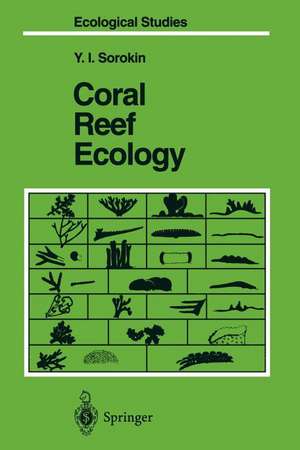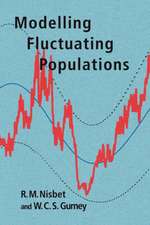Coral Reef Ecology: Ecological Studies, cartea 102
Autor Yuri I. Sorokinen Limba Engleză Paperback – dec 1995
Din seria Ecological Studies
- 18%
 Preț: 1118.93 lei
Preț: 1118.93 lei -
 Preț: 553.71 lei
Preț: 553.71 lei - 18%
 Preț: 1680.55 lei
Preț: 1680.55 lei - 18%
 Preț: 1003.38 lei
Preț: 1003.38 lei - 20%
 Preț: 1004.69 lei
Preț: 1004.69 lei -
 Preț: 480.62 lei
Preț: 480.62 lei - 5%
 Preț: 752.26 lei
Preț: 752.26 lei - 15%
 Preț: 643.99 lei
Preț: 643.99 lei - 15%
 Preț: 644.18 lei
Preț: 644.18 lei - 15%
 Preț: 652.49 lei
Preț: 652.49 lei -
 Preț: 382.36 lei
Preț: 382.36 lei - 15%
 Preț: 643.48 lei
Preț: 643.48 lei - 15%
 Preț: 646.30 lei
Preț: 646.30 lei - 15%
 Preț: 634.32 lei
Preț: 634.32 lei -
 Preț: 384.86 lei
Preț: 384.86 lei - 18%
 Preț: 789.98 lei
Preț: 789.98 lei - 15%
 Preț: 645.14 lei
Preț: 645.14 lei - 15%
 Preț: 649.39 lei
Preț: 649.39 lei - 18%
 Preț: 1005.43 lei
Preț: 1005.43 lei - 18%
 Preț: 949.23 lei
Preț: 949.23 lei - 15%
 Preț: 649.54 lei
Preț: 649.54 lei - 15%
 Preț: 643.34 lei
Preț: 643.34 lei - 15%
 Preț: 649.71 lei
Preț: 649.71 lei - 15%
 Preț: 638.76 lei
Preț: 638.76 lei - 18%
 Preț: 957.62 lei
Preț: 957.62 lei - 18%
 Preț: 1235.25 lei
Preț: 1235.25 lei - 18%
 Preț: 962.18 lei
Preț: 962.18 lei - 18%
 Preț: 949.23 lei
Preț: 949.23 lei - 15%
 Preț: 660.68 lei
Preț: 660.68 lei -
 Preț: 397.76 lei
Preț: 397.76 lei - 15%
 Preț: 638.24 lei
Preț: 638.24 lei - 18%
 Preț: 942.31 lei
Preț: 942.31 lei - 18%
 Preț: 1232.57 lei
Preț: 1232.57 lei - 15%
 Preț: 651.34 lei
Preț: 651.34 lei - 18%
 Preț: 952.72 lei
Preț: 952.72 lei - 18%
 Preț: 1834.27 lei
Preț: 1834.27 lei - 18%
 Preț: 1229.10 lei
Preț: 1229.10 lei -
 Preț: 423.95 lei
Preț: 423.95 lei - 18%
 Preț: 948.92 lei
Preț: 948.92 lei
Preț: 789.83 lei
Preț vechi: 963.21 lei
-18% Nou
Puncte Express: 1185
Preț estimativ în valută:
151.15€ • 156.15$ • 125.80£
151.15€ • 156.15$ • 125.80£
Carte tipărită la comandă
Livrare economică 25 martie-08 aprilie
Preluare comenzi: 021 569.72.76
Specificații
ISBN-13: 9783540605324
ISBN-10: 3540605320
Pagini: 480
Ilustrații: X, 465 p. 2 illus.
Dimensiuni: 155 x 235 x 25 mm
Greutate: 0.67 kg
Ediția:1995
Editura: Springer Berlin, Heidelberg
Colecția Springer
Seria Ecological Studies
Locul publicării:Berlin, Heidelberg, Germany
ISBN-10: 3540605320
Pagini: 480
Ilustrații: X, 465 p. 2 illus.
Dimensiuni: 155 x 235 x 25 mm
Greutate: 0.67 kg
Ediția:1995
Editura: Springer Berlin, Heidelberg
Colecția Springer
Seria Ecological Studies
Locul publicării:Berlin, Heidelberg, Germany
Public țintă
ResearchCuprins
1 Reef Lime Constructions.- 1.1 Geological History, Features of Geomorphology.- 1.2 Biological Factors of Formation and Erosion.- 1.3 Bottom Sediments.- 2 Reef Environments.- 2.1 Hydrodynamics and Thermohaline Features of Reef Waters.- 2.2 Nutrients.- 2.3 Organic Matter in Reef Waters.- 3 Plankton in Coral-Reef Waters.- 3.1 Bacterioplankton.- 3.2 Phytoplankton.- 3.3 Zooplankton.- 4 Benthic Microflora, Periphyton and Plant Associations.- 4.1 Bacteria and Microalgae in Reef Bottom Sediments.- 4.2 Periphytonic Overgrowth.- 4.3 Bottom Plant Associations.- 5 Reef Zoobenthos.- 5.1 Molluscs.- 5.2 Sponges.- 5.3 Wormlike Animals.- 5.4 Benthic Crustaceans.- 5.5 Reef Echinoderms.- 5.6 Tunicates.- 5.7 Bryozoans.- 5.8 Foraminifera and Other Benthic Protozoa.- 5.9 Insects.- 5.10 Distribution, Communities Structure and Abundance.- 6 Coral Reef Fish.- 6.1 Introduction, Diversity, Taxonomy.- 6.2 Communities Structure, Abundance, Distribution.- 6.3 Feeding of Reef Fish.- 6.4 Aspects of Behaviour.- 6.5 Propagation of Reef Fish.- 6.6 Conclusion.- 7 Communities of Corals in Reef Ecosystems.- 7.1 Coral Communities: Composition and Formation.- 7.2 Communities Structure of Reef Corals.- 7.3 Factors Controlling Coral Community Structure.- 7.4 Reproduction of Corals.- 8 Morphology and Ecological Physiology of Corals.- 8.1 Features of Ecological Morphology.- 8.2 Biomass of Living Tissues.- 8.3 Ecological and Physiological Aspects of Endosymbiosis.- 8.4 Ecological Physiology of Photosynthesis in Corals.- 8.5 Ecological Biochemistry of Corals.- 9 Nutrition of Corals.- 9.1 Autotrophic Feeding of Corals.- 9.2 Heterotrophic Feeding of Corals.- 9.3 Energy Balance and Specific Growth Rate of Corals.- 10 Biogeochemical Metabolism and Energy Flows in Reef Ecosystems.- 10.1 Biogeochemical Metabolism of Organic Matter.- 10.2 Biogeochemical Metabolism of Other Elements.- 10.3 Model Studies and Energy Budget in Reef Ecosystems.- 11 Destruction and Recovery of Reef Systems, Reef and Man.- 11.1 The Acanthaster Problem.- 11.2 Destruction of Corals by Physical Stress.- 11.3 Coral Diseases.- 11.4 Anthropogenic Impacts.- 11.5 Reef Fishery.- 11.6 Problems of Monitoring and Rational Use of Reef Resources.- 11.7 Protection, Monitoring and Rational Use of Resources; Artificial Reefs.- References.

















